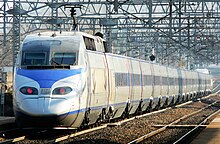Rail transport in South Korea
| Republic of Korea | |||||
|---|---|---|---|---|---|

KTX train
|
|||||
| Operation | |||||
| National railway | Korail | ||||
| Infrastructure company | KRNA | ||||
| Major operators | Mainline: Korail only Rapid transit: Various |
||||
| System length | |||||
| Total | 3,249.6 km (2,019.2 mi) | ||||
| Double track | 1,403.5 km (872.1 mi) | ||||
| Electrified | 2,031.3 km (1,262.2 mi) | ||||
| High-speed | 368.4 km (228.9 mi) | ||||
| Track gauge | |||||
| Main | 1,435 mm (4 ft 8 1⁄2 in) | ||||
| High-speed | 1,435 mm (4 ft 8 1⁄2 in) | ||||
| Electrification | |||||
| Main | 25 kV AC | ||||
| 25kV AC | All Korail operated network except Ilsan Line, AREX | ||||
| 1.5kV DC | All rapid transit networks including Korail Ilsan Line | ||||
| Features | |||||
| No. stations | 638 | ||||
| Highest elevation | 855 m (2,805 ft) | ||||
| at | Chujeon Station | ||||
|
|||||
| Map | |
|---|---|
The rail transportation system in South Korea includes mainline railway lines and rapid transit system in some major cities.
In 1896, a concession was granted to American businessmen, Henry Collbran and Harry R. Bostwick, to construct the Seoul-Chemulpo (Jemulpo) Railroad (SCRR). Its opening was on March 22, 1897. On September 18, 1899, the SCRR was officially opened for traffic from Jemulpo to the south bank of the Han River near Yeongdeungpo. Railroad operations in Seoul did not begin until July 8, 1900, when the Han River was finally bridged. On May 8, 1902, the French-operated railroad financed by the Korean Empire, Northwestern Railway (NWR) was established and completed in 1905. It would connect Seoul with Manchuria by way of Kaesong, Pyongyang and Sinuiju on the Yalu River. During the Japanese occupation of Korea, the railways were operated by the Chosen Government Railway and various privately owned companies.
Other major lines were later lain during the colonial period; these included lines originating in Mokpo, Masan, and Busan. These lines connected to Seoul and to Sinuiju in North Korea, where they were linked with the Trans-Siberian Railway. The railroad network was badly damaged during the Korean War, but it was later rebuilt and improved.
Established in September 1963, the Korean National Railroad, an agency of the Ministry of Transportation, was in charge of all rails throughout the 1970s and 1980s and continued electrifying heavily used tracks and laying additional tracks. As of 1987, the combined length of the country's railroad network was approximately 6,340 kilometers, including approximately 761.8 kilometers of double track railroad and 1,023 kilometers of electrified railroad. Suburban lines were electrified and connected to the Seoul subway system. Rolling stock included 459 diesel locomotives, 90 electric locomotives, 133 motor coaches, and 370 electric motor cars.
...
Wikipedia

